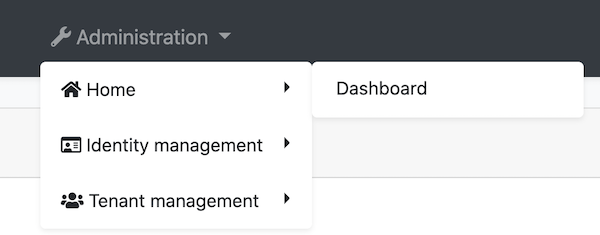5.8 KiB
修改菜单
菜单在 @abp/ng.theme.basic包 ApplicationLayoutComponent 内部. 有几种修改菜单的方法,本文档介绍了这些方法. 如果你想完全替换菜单,请参考[组件替换文档]了解如何替换布局.
如何添加Logo
环境变量中的 logoUrl 是logo的url.
你可以在 src/assets 文件夹下添加logo并设置 logoUrl:
export const environment = {
// other configurations
application: {
name: 'MyProjectName',
logoUrl: 'assets/logo.png',
},
// other configurations
};
如何添加导航元素
通过 AppRoutingModule 中的 routes 属性
你可以通过在 app-routing.module 中将路由作为子属性添加到路由配置的 data 属性来定义路由. @abp/ng.core 包组织路由并将其存储在 ConfigState 中.ApplicationLayoutComponent 从存储中获取路由显示在菜单上.
你可以像以下一样添加 routes 属性:
{
path: 'your-path',
data: {
routes: {
name: 'Your navigation',
order: 3,
iconClass: 'fas fa-question-circle',
requiredPolicy: 'permission key here',
children: [
{
path: 'child',
name: 'Your child navigation',
order: 1,
requiredPolicy: 'permission key here',
},
],
} as ABP.Route, // can be imported from @abp/ng.core
}
}
name是导航元素的标签,可以传递本地化密钥或本地化对象.order排序导航元素.iconClass是i标签的类,在导航标签的左侧.requiredPolicy是访问页面所需的权限key. 参阅 权限管理文档childrenis an array and is used for declaring child navigation elements. The child navigation element will be placed as a child route which will be available at'/your-path/child'based on the givenpathproperty.children是一个数组,用于声明子菜单,它基于给定的path属性,路径是在/your-path/child.
添加了上面描述的route属性后,导航菜单如下图所示:
通过 ConfigState
ConfigStateService 的 dispatchAddRoute 方法可以向菜单添加一个新的导航元素.
// this.config is instance of ConfigStateService
const newRoute: ABP.Route = {
name: 'My New Page',
iconClass: 'fa fa-dashboard',
path: 'page',
invisible: false,
order: 2,
requiredPolicy: 'MyProjectName.MyNewPage',
} as Omit<ABP.Route, 'children'>;
this.config.dispatchAddRoute(newRoute);
// returns a state stream which emits after dispatch action is complete
newRoute 放在根级别,没有任何父路由,url将为/path.
如果你想 添加子路由, 你可以这样做:
// this.config is instance of ConfigStateService
// eIdentityRouteNames enum can be imported from @abp/ng.identity
const newRoute: ABP.Route = {
parentName: eIdentityRouteNames.IdentityManagement,
name: 'My New Page',
iconClass: 'fa fa-dashboard',
path: 'page',
invisible: false,
order: 3,
requiredPolicy: 'MyProjectName.MyNewPage'
} as Omit<ABP.Route, 'children'>;
this.config.dispatchAddRoute(newRoute);
// returns a state stream which emits after dispatch action is complete
newRoute 做为 eIdentityRouteNames.IdentityManagement 的子路由添加, url 设置为 '/identity/page'.
新路由看起来像这样:
如何修改一个导航元素
DispatchPatchRouteByName 方法通过名称查找路由,并使用二个参数传递的新配置替换存储中的配置.
// this.config is instance of ConfigStateService
// eIdentityRouteNames enum can be imported from @abp/ng.identity
const newRouteConfig: Partial<ABP.Route> = {
iconClass: 'fas fa-home',
parentName: eIdentityRouteNames.Administration,
order: 0,
children: [
{
name: 'Dashboard',
path: 'dashboard',
},
],
};
this.config.dispatchPatchRouteByName('::Menu:Home', newRouteConfig);
// returns a state stream which emits after dispatch action is complete
- 根据给定的
parentName将 Home 导航移动到 Administration 下拉框下. - 添加了 icon.
- 指定了顺序.
- 添加了名为 Dashboard 的子路由.
修改后,导航元素看起来像这样:
如何在菜单的右侧添加元素
右侧的元素存储在 @abp/ng.theme.basic 包的 LayoutState 中.
LayoutStateService 的 dispatchAddNavigationElement 方法添加元素到右侧的菜单.
你可以通过将模板添加到 app.component 调用 dispatchAddNavigationElement 方法来插入元素:
import { Layout, LayoutStateService } from '@abp/ng.theme.basic'; // added this line
@Component({
selector: 'app-root',
template: `
<!-- Added below content -->
<ng-template #search
><input type="search" placeholder="Search" class="bg-transparent border-0"
/></ng-template>
`,
})
export class AppComponent {
// Added ViewChild
@ViewChild('search', { static: false, read: TemplateRef }) searchElementRef: TemplateRef<any>;
constructor(private layout: LayoutStateService) {} // injected LayoutStateService
// Added ngAfterViewInit
ngAfterViewInit() {
const newElement = {
name: 'Search',
element: this.searchElementRef,
order: 1,
} as Layout.NavigationElement;
this.layout.dispatchAddNavigationElement(newElement);
}
}
上面我们在菜单添加了一个搜索输入,最终UI如下:s
如何删除右侧菜单元素
TODO



